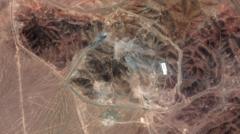CIA Director John Ratcliffe asserts that US strikes have substantially crippled Iran's nuclear capabilities, contradicting a leaked Pentagon assessment that claims minimal impact. As tensions rise, President Trump maintains the assertion of severe damage while seeking future negotiations with Iran.
CIA Claims Iran's Nuclear Facilities Heavily Damaged Amid Contradictory Assessments

CIA Claims Iran's Nuclear Facilities Heavily Damaged Amid Contradictory Assessments
Conflicting evaluations emerge following US military strikes on Iran's nuclear sites, as CIA director insists on significant damage while a Pentagon report offers a different perspective.
The head of the CIA, John Ratcliffe, has declared that the recent US military strikes have "severely damaged" Iran's nuclear facilities, significantly hindering the nation's nuclear program for years to come. His statement stands in stark contrast to a leaked preliminary assessment from a Pentagon intelligence agency, which suggested that many core components of Iran's nuclear endeavors remained undamaged after the strikes.
President Donald Trump echoed Ratcliffe's sentiments, expressing on social media that the media had misrepresented the facts regarding the extent of damage inflicted on Iran's facilities in the strikes. During a NATO summit in The Hague, Trump characterized the operation as one of "obliteration," stating he would likely pursue commitments from Iran concerning its nuclear program in upcoming talks.
The US operated an extensive military response involving 125 aircraft, which targeted Iran's key nuclear infrastructures: Natanz, Fordo, and Isfahan. While Ratcliffe mentioned that strategic intelligence indicates significant destruction, the Pentagon's Defense Intelligence Agency evaluation claimed the strikes would only set back Iran’s nuclear efforts by a few months. Such conflicting evaluations reflect the challenge of accurately assessing military operations, as different intelligence agencies may reach varying conclusions based on their functions and mandates.
US Defense Secretary Pete Hegseth described the Pentagon report as low-confidence, leading to further uncertainties surrounding the extent of the damage. Further complicating matters, Israeli Atomic Energy Commission reports claimed that the US strikes had destroyed critical infrastructure at Fordo, pushing Iran's nuclear ambitions back by many years. However, Iranian officials reportedly downplayed the extent of the damage, with Esmail Baghaei from the Iranian foreign ministry stating that nuclear installations had sustained significant, yet recoverable damages.
In the aftermath of the strikes, tensions continue to simmer as communication lines between the US and Iran appear to be open—indicating potential future negotiations, although Iran has not confirmed any talks. Satellite images released have depicted craters at various sites, prompting speculation about the effectiveness of the strikes against Iran's heavily fortified nuclear facilities.
As these circumstances unfold, the complexities of US-Iran relations remain as contentious as ever, reflecting a delicate balance of military strategy, international diplomacy, and regional security.





















